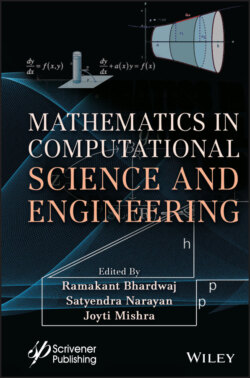Читать книгу Mathematics in Computational Science and Engineering - Группа авторов - Страница 50
2.5 Theoretical Basis for Multi-Dimensional Resistivity Inversion Technqiues
ОглавлениеThere are two important steps for the inversion of electrical data as shown below:
A fast numerical modelling scheme, which computes electrical data theoretically for a given numerical/physical model (i.e., a fast “forward modelling scheme”), and
An efficient numerical approach to compute first derivatives of the data (also called “coefficient matrix”).
Unfortunately, the second requirement is not easily ready for 2-D or 3-D inverse geophysical and geological models. Furthermore, there is no claim for an optimum inverse technique or approach for the interpretation of 2-D and/or 3-D geophysical data. The purpose of this article is to introduce an effective solution for this problem and to propose multi-dimensional electrical resistivity inversion techniques.
Based on “reciprocity theorem (1961)” and “perturbation analysis”, a new method for the multi-dimensional resistivity inversion is introduced herein. This approach for inverse formulation is entirely different from resistivity inversion methods published in the geophysical literature. The main benefits of the proposed method are listed here:
The first derivatives of the data with respect to the model properties are computed efficiently.
It provides a mathematical picture of sensitivity analysis. It is expressed as an amount of power that is lost in the anomalous zone.
The governing equations (also known as “Poisson” equation) for potential field distribution due to a 3-D direct current (DC) point source Is(x, y, z) are given by [26]
(2.1)
and
(2.2)
In the above equations, φ(x, y, z) represents electrical potential field distribution, Is(x, y, z) 3-D direct current point source, J(x, y, z) represent current density, and ρ(x, y, z) describes three-dimensional distribution of electrical resistivity of the medium around the point source. The fundamental equations (2.1) and (2.2), representing potential field distribution (φ) and the electrical current density (J) due a point source (I), may be rewritten in different notations as shown below:
(2.3)
where
(2.4)
A perturbation analysis is performed here to study or investigate sensitivity of the potential field. Use a vertical cross-section of the 3-D model and changing electrical resistivity at depth by a small amount (Figure 2.1), equation (2.3) may be rewritten as shown in equation (2.5).
(2.5)
where
(2.6)
After expanding equation (2.5) completely and upon neglecting second-order terms here, it gives
(2.7)
Figure 2.1 This is a vertical cross-section of a 3-D model. The model represents an anomalous zone. Electrical resistivity of the anomalous zone is perturbed. Reciprocity may be achieved by interchanging the current and potential dipoles.
Equations (2.3) and (2.7) are compared here. Upon comparison of these two equations, it is observed that small changes in electrical potential field distribution is related to small changes in electrical resistivity of the medium. Also, in equation (2.7) behaves as current source for changes in potential fields.
Now, let us consider the “generalized Green’s identity” of Lanczos [27], which is an integral over volume τ
(2.8)
If the adjoint problem D and its boundary conditions are chosen properly, then F(u*,V) will vanish and the Green’s identity will reduce to the bilinear identity
(2.9)
The adjoint system is
(2.10)
Here, ~ denotes Hermitian and * denotes complex conjugate. If
(2.11)
then we can write
(2.12)
In order to get expressions for VT (Du)*, we need to write complete differentials
(2.13)
(2.14)
(2.15)
Similar expressions for VT(DTu*) can be written for the y and z variables. Thus, the expression for VT(DTu*) will be
(2.16)
(2.17)
(2.18)
(2.19)
then the adjoint system of equation DTu* = γ* will be written as
(2.20)
and
(2.21)
The above analysis will also yield the expression for F(u*,V), which is
(2.22)
Rewriting the boundary terms
(2.23)
Substituting u1, u2, u3, and u4 values yields
(2.24)
Rewriting the boundary term again, it gives
(2.25)
Changing to the surface integral, it becomes
(2.26)
As the extended Green’s theorem is valid regardless of the field substituted for u and V, we replace V by δV in the bilinear identity. If the sides and bottom surfaces are chosen far enough from the anomalous region, then δρ and δJ will be zero. At the top surface, J and J′ are parallel to the surface, and J·ds = 0. Therefore, the boundary term vanishes and equation (2.10) becomes
(2.27)
Substituting equation (2.7) and (u)* = γ* in the above expression, one obtains
(2.28)
This expression can be rewritten using expressions for δVT, γ*, δD, V, and u*
(2.29)
or
(2.30)
Considering a unit point source I’s = δ(x - x0) δ(y - y0) δ(z) at the observation point, the above equation becomes
(2.31)
Using equation (2.31), small changes in the potential field distribution due to small changes in electrical resistivity of a 3-D model may be expressed in a different format. Assuming the 3-D model is discretized into small individual blocks, equation (2.31) may be rewritten further in algebraic notation representing power loss or dissipated in the blocks. For a given electrode geometry (Figure 2.1), equation (2.31) becomes
(2.32)
The current densities for each block can be computing using a forward resistivity modelling scheme, so that the equation (2.32) reduces to
(2.33)
The above relationship may further be simplified for 2-D and 1-D models. The current density in Y-coordinate direction of 2-D geologic model is negligible and the average current density in the strike direction is zero, in which case, equation (2.33) becomes
(2.34)
for 2-D geologic models, or
(2.35)
for 1-D geologic models.
